The History Of AUDI TT

The Audi TT is a sports car manufactured by Audi since 1998 in Győr, Hungary, now in its second generation — and available as a 2+2 coupé or two-seater roadster.
The development of the Audi TT began in September 1994 at the Audi Design Center in California. The TT was first shown as a concept car at the 1995 Frankfurt Motor Show. The design is credited to J Mays and Freeman Thomas with Martin Smith contributing to the award winning interior design. A previously unused laser welding adaptation that enabled seamless design features on the first-generation TT, also delayed its introduction.
Audi did not initially include an automatic transmission option for the TT. A DSG (S-Tronic) became available, the first for a production car, in 2003.
The TT is named for the successful racing tradition of NSU in the British Isle of Man TT motorcycle race. NSU began competing in the TT in 1911 and later merged into the company now known as Audi. The Audi TT also follows the NSU 1000TT, 1200TT and TTS cars of the 1960s in being named for the race.
The Audi TT Roadster was presented in Detroit in 1999 under the name Audi TTS. After one year the name was changed to Audi TT Roadster.[citation needed]
The production model (internal designation Typ 8N) was launched as a coupé in September 1998, followed by a roadster in August 1999, based on the Volkswagen Group A4 (PQ34) platform used for the Volkswagen Golf Mk4, Skoda Octavia and others. The styling differed little from the concept, except for slightly reprofiled bumpers and the addition of a rear quarterlight windows behind the doors.
Mechanically, the TT uses a transversely mounted engine with front or quattro four-wheel drive. It was first available with a 1.8L turbocharged inline four cylinder 20-valve engine, with either 180PS (132kW) or 225PS (165kW). The engines share the same basic design but the 225PS version features a larger turbocharger, an additional intercooler on the driver's side, forged connecting rods, a dual exhaust, and a few other internals designed to accommodate the increase in turbo boost from roughly 10 psi peak to 15. Haldex enabled four wheel drive branded as quattro was optional on the 180PS (132kW) engine, and standard on the more powerful version.
Early TT models gained press coverage for a series of high-speed accidents in Europe. Reported crashes and related fatalities occurred at speeds in excess of 110mph (180km/ h) during abrupt lane changes or sharp turns. Both the coupe and roadster models were recalled in late 1999/ early 2000 to improve predictability of the car's handling at very high-speeds. Audi's Electronic Stability Programme, and rear spoiler were added, along with suspension modifications. All changes were subsequently incorporated into future versions of the car.
The original four cylinder engine range was complemented with a 250PS (184kW) 3.2L VR6 in early 2003, which comes with the quattro four-wheel drive system. In October 2004 a new DSG (dual-clutch) gearbox, which improves acceleration through drastically reduced shift time, was offered along with a stiffer suspension.
Audi also developed a lightened and more powerful "quattro Sport" model, with 240PS (177kW) and a top speed of 250km/ h (155mph).
There are two class action lawsuits affecting specific model years of the first generation TT.
On January 22, 2008 the U.S. District Court, Northern District of California, entered an order preliminarily approving a nationwide settlement of a class action lawsuit brought by Green Welling LLP on behalf of all current and prior owners and lessees of 2000-2004, and 2005 model year Audi TTs. The lawsuit and settlement relate to allegedly defective instrument clusters, and Audi TT owners are entitled to submit claims for repairs, replacement and/ or cash reimbursement for out-of-pocket expenses, and all TT owners covered by the suit will receive a 2-year extension of their existing 4-year warranty (limited to the instrument cluster).
On June 22, 2007 Pearson, Simon, Soter, Warshaw & Penny, LLP and the Law Office of Robert L. Starr filed a class action lawsuit against Volkswagen alleging that the timing belts for model year 1999-2003 Audi and Volkswagen vehicles equipped with a 1.8 litre turbo-charged engine fail prematurely. The vehicles included are the Audi TT, Audi A4 and Volkswagen Passat. The complaint alleges that the timing belts fail prior to the service interval, as stated in the owner's manual. The parties have reached a class-wide settlement and preliminary approval of the settlement was granted by the court on May 19, 2008. Claim forms, class notice and other documentation will be mailed on or about August 1, 2008. Details regarding the terms of the settlement will be in the notice sent to owners of the class vehicles.
A preview of the second-generation TT was provided in the form of the Audi Shooting Brake concept car, shown at the Tokyo Motor Show in 2005. This concept was based on the new TT, but featured angular styling and a "shooting brake" 2-door hatchback body style.
Audi revealed the second-generation TT, internal designation Typ 8J, on April 6, 2006. It is constructed of aluminium in the front, and steel in the rear, to enhance its balance and is available in front- or four-wheel drive. The production car uses either the 3.2L VR6 engine, with 250PS (184kW), or a 200PS (147kW) version of Audi's direct injection 2.0L four. Better known as FSI, Fuel Stratified Injection, the technology was derived from the Le Mans race cars, and offers improved fuel efficiency as well as an increased power output. A 6-speed manual transmission is standard, with the Direct-Shift Gearbox (DSG) as an option, and quattro four-wheel drive is standard with the VR6, while optional on the 2.0T.
Audi's new active suspension, Audi Magnetic Ride, is available as an option, and is based on Delphi's MagneRide magneto rheological dampers (which means that the suspension will automatically adjust depending on the current road conditions). The new TT also features an improved rear spoiler that automatically extends at speeds greater than 120km/ h (75mph), and retracts again at 80km/ h (50mph). The spoiler can also be manually controlled by the driver via a switch on the dash. It is again offered as a 2+2 coupé and as a roadster.
In 2005 Audi released the limited edition (of 1000 examples) TT quattro Sport. It had increased power from its 1.8-litre turbocharged engine - giving 240PS (177kW; 237bhp) and 236lb (107kg) ft of torque - and a reduction in weight of 49kg (108lb) to 1,416kg (3,122lb). This was achieved by deleting the spare wheel and by taking out the rear parcel shelf and rear seats. Fixed-back Recaro bucket seats graced the interior. Distinguishable from other TT coupes by its two-tone paint scheme (black painted roof, pillars and mirror housings in combination with either Avus Silver, Phantom Black, Mauritius Blue or Misano Red body colour) and unique 18-inch (460mm), 15-spoke aluminium wheels, plus the same body kit as fitted to the TT 3.2 V6, it also had uprated suspension settings, V6-spec brakes fitted and the new wheels were wider at the rear for improved grip.
In the 2008 Detroit Motor Show, Audi released the TTS with a 2.0TFSI engine tuned to 272PS (200kW; 268bhp). It will feature quattro four wheel drive and come with a choice of a six speed manual or six speed S tronic DSG. In the United States, only the S tronic gearbox will be available.
A higher-end TT-RS is under development, it is confirmed that this will use a turbocharged 2.5L 5-cylinder engine, that will develop 340PS (250kW; 335bhp). The TT-RS will also feature quattro four wheel drive, and come standard with a six-speed manual gearbox.[citation needed]
In 2008, Audi offered the second generation TT Coupé as a 2.0 TDI quattro, and TT Roadster 2.0 TDI quattro for the European market. Audi said average fuel consumption on the engine is 5.3 liters/ 100 km or 44.4 mpg in the coupé variant.
The TT was nominated for the North American Car of the Year award for 2000. It was also on Car and Driver magazine's Ten Best list for 2000 and 2001.
The second generation TT has been honored with many awards including the inaugural Drive Car of the Year, Top Gear Coupé of the Year 2006, Fifth Gear Car of the Year 2006, Autobild 'Most Beautiful Car' and World Design Car of the Year 2007, as well as being a finalist for World Car of the Year.
From Wikipedia, the free encyclopedia
More About AUDI TT
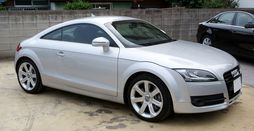
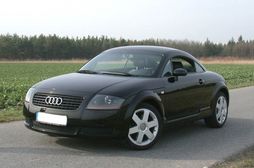
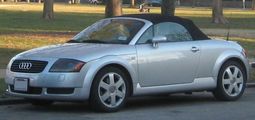
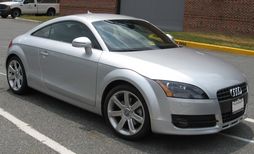
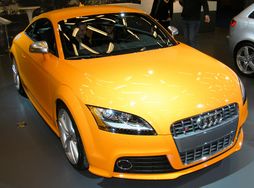
|